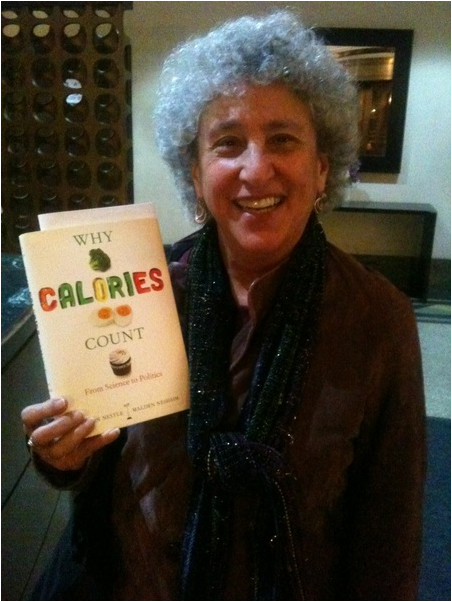
Order from your local independent bookstore or University of California Press or Barnes and Noble or Amazon.com.
Reviews, interviews, and commentary on Why Calories Count
2014
July 26 Review in Science Magazine
2013
September Review in Health Affairs 2012;31 (9):2150-2151.
September 7 Radio interview with Dr. Don
August 15 Review in Frankfurter Allgemeine Zeitung by Thomas Weber (in German)
August 1 Review in the American Journal of Clinical Nutrition by Barbara Rolls
July 26 Interview with Tami O’Neill for EcoCentric blog
July 13 Interview with Donna Feldman on MyNetDiaryBlog
July 19 Interview about Why Calories Count with Nina Kahori Fallenbaum for Hyphen magazine: “Rice is Nice.”
June 6 KQED’s Forum (radio) Host: Spencer Michels
May 25 Video interview with Linda Watson on HuffPo.
May 21 Radio New Zealand
May 15 Radio interview with Susan Moran
May 14 TV Interview with Linda Watson on Cook for Good
May 9 Jenny Hutt radio
May 9 Candy Sagon on the AARP blog
May 4 Fort Worth Star-Telegram
May 2 Oprah.com
April 26 Review in Eat.Drink.Better
April 26 Susan Albers in the Huffington Post
April 24 Review on StarChildScience
April 20 Review in the Wall Street Journal
April 19 Interview with LifeScript
April 18 Review on The Black Sheep Dances.
April 17 The Page 99 Test and Campaign for the American Reader’s Page 99 of Why Calories Count.
April 16 A review in Serious Eats by Leah Douglas.
March 29: Times Higher Education (U.K.)
People should read this book. They should read it if they are obsessive weight-watchers or serial dieters, or just concerned about what their children eat. They should read it if they work in public health, the food industry, catering or education. And they should certainly read it if, like my colleague who reacted with horror to the title and the idea, they work to counter the “myth of obesity” and are supporters of the “health at any size” movement.
March 29: a blog from Finland (in Finnish)
March 28: Healthy Eating blog
March 26: Lisa Young’s portion teller blog
March 25: Miriam Morgan’s review in the San Francisco Chronicle
March 22: Eleanor West’s interview on Civil Eats.
March 21: Mark Bittman in the New York Times
March 20: Jane Brody in the New York Times
March 15: Nature magazine
Obesity has gone global — as has misinformation about nutrition and food. Nutrition scientists Marion Nestle and Malden Nesheim unscramble the confusion with a serving of science. They reveal how calories — those potent but ill-understood measures of heat energy — are really counted, why we need them, how we use them, how many we actually need and why it all sometimes goes so wrong. From ‘secret’ calories to food politics, malnourishment and calorie restriction for health, this is a feast for the mind.
February 1: The Scientist
Nutritional science guru Marion Nestle’s new book, Why Calories Count, seeks to crack open the inscrutable nature of the calorie. Think of the book, cowritten with Cornell University nutritionist and biochemist Malden Nesheim, as a diner’s elemental guide to eating. Nestle and Nesheim deconstruct the calorie—the bane of many a belly in the developed and developing worlds—to its barest components as a humble unit of work or heat before reassembling it and discussing its implications for disease, obesity, politics, and modern marketing.
From the strict chemical definition of a calorie to the 25-year quest by the Center for Science in the Public Interest to require nutritional labels, including calories, on alcoholic beverages, Why Calories Count weaves scientific and social tales into a rich portrait of the American diet and the laws that have shaped it.
By thoroughly burrowing into the meaning and impacts of calories, the authors intend to bestow a more relaxed yet active state of mind upon the reader. “Get organized. Eat less. Move more. Get political,” they suggest. Sounds like the most succinct diet book ever written.
Excerpts from other reviews
From Kirkus Reviews: A strong, rigorous overview of the calorie, its regulation and the politics behind food labeling and marketing.
From Library Journal (see the Barnes and Noble website): Neither a diet nor a weight-loss book, this scholarly, seriously researched work assists readers in evaluating diet claims, formulating strategies to lose, gain, or maintain weight, and learning how to make healthy food choices….and—what will probably be of most interest to the general reader—the role of big business in creating calorie-laden food and why it’s less politically controversial to recommend exercising than cutting back on calories.
Summary
Calories—too few or too many—are the source of health problems affecting billions of people in today’s globalized world. Although calories are essential to human health and survival, they cannot be seen, smelled, or tasted. They are also hard to understand.
This book explains in clear and accessible language what calories are and how they work, both biologically and politically. It takes readers through issues fundamental to understanding diet and food, weight gain, loss, and obesity, and sorts through the misinformation put forth by food manufacturers and diet program promoters.
Nestle and Nesheim explain the political stakes and show how federal and corporate policies have come together to create an “eat more” environment and give readers the information needed to interpret food labels, evaluate diet claims, and understand evidence as presented in popular media.
Their concluding advice: Get organized. Eat less. Eat better. Move more. Get political.
Blurbs for Why Calories Count:
“We need to understand what ‘empty calories’ are, so that we can feed our children food that is truly nourishing. On this topic, there is no better teacher than Marion Nestle, who writes with meticulousness, clarity and grace.” —Alice Waters, author of The Art of Simple Food
“If you want to understand what’s wrong with our eating habits, you must understand the central role that calories play. Nestle and Nesheim are two of the America’s finest nutritionists–and this book explains, clearly and succinctly, why calories count. It is essential reading not only for people interested in food policy, but for everyone who wants to eat well and be well.” —Eric Schlosser, author of Fast Food Nation
“This superbly well-researched and scientifically sound book makes it clear how today’s food environment often overrides physiological regulatory controls of body weight. Why Calories Count is essential reading for anyone who wants to understand why so much about food choice lies in the hands of food marketers whose goal is to sell more products, not necessarily in the interests of public health.” —Dr. David Kessler, author of The End of Overeating

“Thank god authorities like Nestle and Nesheim have teamed up to give us an epic view of a calorie: what it is, where it came from, what it means, how and why we count them. Thank god they’ve managed to decode nutritional science into a commonsense language we can all understand. And thank god they’ve put calories in their place in a wider cultural and political context to help us think meaningfully about the food our lives depend upon. I’m grateful.” —Betty Fussell, author of Raising Steaks
“Calories. We all talk about them—many are even obsessed with them—but what do we really know about them? Not much. Marion Nestle and Malden Nesheim’s latest book changes all that, pulling back the curtain on calories and helping us understand them in a whole new light. You’ll never look at a 100-calorie pack of corporate cookies the same way again.” —Anna Lappé, author of Diet for a Hot Planet






